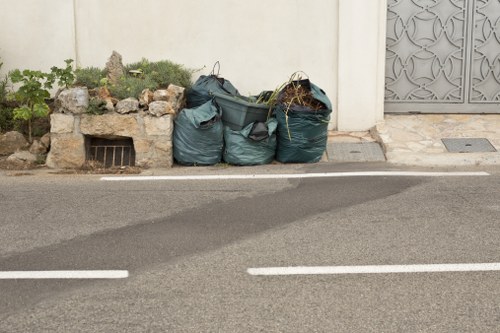Comprehensive Guide to Garden Clearance in Temple

Gardening plays a pivotal role in enhancing the aesthetics and serenity of temples. However, over time, gardens can become cluttered, requiring thorough garden clearance in temple settings. This process not only ensures the upkeep of these sacred spaces but also preserves their natural beauty for worshippers and visitors alike.
Effective garden clearance involves removing unwanted debris, pruning overgrown plants, and ensuring that the landscape remains both functional and visually appealing. It is essential for maintaining the sanctity and cleanliness of temple grounds.
Moreover, regular garden maintenance helps in preventing pest infestations and diseases that can damage plant life, ensuring that the temple remains a peaceful haven for all.

The Importance of Garden Clearance in Temples
Maintaining a well-kept garden in a temple is crucial for several reasons. Firstly, it creates a serene environment conducive to meditation and prayer. A tidy garden reflects the discipline and dedication of the temple community.
Secondly, garden clearance prevents the accumulation of fallen leaves and organic matter, which can become breeding grounds for pests and diseases. This proactive approach ensures the longevity of the plant species within the temple grounds.
Additionally, a clean garden enhances the overall aesthetic appeal of the temple, making it more inviting for devotees and tourists. This can lead to increased footfall and support for the temple's activities and maintenance.

Steps Involved in Effective Garden Clearance
Assessment and Planning
Before commencing any garden clearance project, it is essential to conduct a thorough assessment of the current state of the garden. This involves identifying overgrown areas, dead plants, and any structural elements that may need attention.
Planning is the next critical step, where a detailed strategy is formulated to address the identified issues. This includes deciding on the tools and manpower required, as well as setting a timeline for the project.
Proper planning ensures that the garden clearance process is efficient and minimizes disruption to the temple's daily activities.

Tools and Equipment for Garden Clearance
Having the right tools and equipment is fundamental for effective garden clearance. Common tools used include:
- Pruning shears and loppers for trimming overgrown branches.
- Rakes and leaf blowers for gathering and removing debris.
- Gloves and protective clothing to ensure the safety of the workers.
- Wheelbarrows and carts for transporting heavy materials.
Using quality tools not only makes the job easier but also ensures that the garden is maintained without causing harm to the plants or the environment.
Additionally, eco-friendly equipment should be favored to minimize the environmental impact of the clearance process.

Hiring Professional Garden Clearance Services
While some temple communities may have the resources to handle garden clearance internally, hiring professional services can often yield better results. Professionals bring expertise and experience, ensuring that the clearance is done efficiently and effectively.
Professional garden clearance teams are equipped with the necessary tools and knowledge to tackle even the most challenging tasks. They can also provide valuable advice on garden maintenance and plant care.
Moreover, outsourcing this task allows the temple staff to focus on their primary responsibilities, ensuring that the garden remains in top condition without overburdening the community members.

Environmentally Friendly Practices in Garden Clearance
Adopting environmentally friendly practices during garden clearance is essential for preserving the ecosystem within the temple grounds. This includes composting organic waste, recycling materials, and using sustainable gardening methods.
Composting not only reduces waste but also provides rich nutrients for the garden, enhancing plant growth and health. Recycling materials like glass, plastic, and metal ensures that they are repurposed, reducing the overall environmental footprint.
Implementing sustainable gardening techniques, such as rainwater harvesting and the use of native plant species, further contributes to the ecological balance of the temple garden.

Benefits of Regular Garden Clearance
Regular garden clearance offers numerous benefits, including:
- Improved Aesthetics: A clean garden enhances the visual appeal of the temple, creating a welcoming atmosphere.
- Healthier Plants: Removing dead or diseased plants prevents the spread of diseases and promotes healthy growth.
- Pest Control: Clearing debris reduces hiding spots for pests, thereby minimizing infestations.
- Safety: Removing overgrown vegetation and debris prevents accidents and ensures the safety of visitors.
These benefits collectively contribute to the overall well-being and sustainability of the temple environment.
Furthermore, a well-maintained garden can serve as a peaceful retreat for meditation and reflection, enhancing the spiritual experience for devotees.

Seasonal Garden Clearance: Adapting to Weather Changes
Different seasons present unique challenges for garden maintenance. Spring and autumn, in particular, require focused garden clearance efforts to prepare for the growing and dormant seasons, respectively.
In spring, clearing out winter debris and pruning new growth helps plants thrive during the warmer months. Conversely, autumn garden clearance involves removing fallen leaves and preparing plants for the colder months ahead.
Adapting garden clearance practices to seasonal changes ensures that the temple garden remains healthy and vibrant throughout the year.

Community Involvement in Garden Clearance
Engaging the temple community in garden clearance can foster a sense of ownership and responsibility towards the sacred space. Organized clean-up events and volunteer days encourage participation and strengthen community bonds.
Providing training and resources to community members empowers them to contribute effectively to garden maintenance. Collaborative efforts not only make the task more manageable but also create a united front in preserving the temple's beauty.
Additionally, involving the community can lead to the sharing of innovative ideas and techniques, enhancing the overall efficiency of the garden clearance process.

Cost-Effective Strategies for Garden Clearance
Cost is often a significant factor in garden maintenance. Implementing cost-effective strategies can ensure that garden clearance is sustainable in the long run.
Some strategies include:
- Preventive Maintenance: Regular small-scale clearances reduce the need for extensive and costly clean-up projects.
- Eco-Friendly Practices: Using composting and recycling not only benefits the environment but also reduces disposal costs.
- Volunteer Programs: Leveraging community volunteer efforts can significantly cut down on labor costs.
By adopting these strategies, temples can maintain their gardens efficiently without straining their financial resources.
Moreover, investing in quality tools and training can result in long-term savings by minimizing the need for frequent replacements and repairs.

Legal and Environmental Considerations
When undertaking garden clearance in temple grounds, it is essential to be aware of local regulations and environmental guidelines. Compliance ensures that the clearance activities do not inadvertently harm the environment or violate any laws.
Permits may be required for significant landscaping changes, and certain plants might be protected under local conservation laws. Being informed and compliant prevents legal issues and supports environmental sustainability.
Furthermore, considering the environmental impact of garden clearance, such as soil health and biodiversity, contributes to the responsible stewardship of the temple's natural resources.

Innovative Techniques in Garden Clearance
Advancements in gardening technology have introduced innovative techniques that enhance the efficiency and effectiveness of garden clearance. Tools like electric trimmers and automated leaf blowers reduce manual labor and increase productivity.
Additionally, the use of smart irrigation systems ensures optimal water usage, promoting sustainable garden practices. These systems can be programmed to deliver precise amounts of water, preventing overwatering and conserving resources.
Incorporating these modern techniques can significantly improve the garden clearance process, making it more streamlined and environmentally friendly.

Preserving Cultural Heritage through Garden Maintenance
Temple gardens often hold cultural and historical significance. Proper garden clearance and maintenance play a crucial role in preserving this heritage for future generations.
By maintaining traditional plant species and landscaping styles, temples can retain their unique identity and cultural essence. This preservation not only honors the past but also educates visitors about the temple's legacy.
Moreover, well-maintained gardens can host cultural events and rituals, providing a rich and immersive experience for attendees.

Common Challenges in Temple Garden Clearance
Despite careful planning, several challenges may arise during garden clearance in temple settings. These include dealing with invasive species, managing large volumes of debris, and ensuring minimal disruption to temple activities.
Invasive species can outcompete native plants, disrupting the garden's ecological balance. Effective strategies, such as manual removal and the use of environmentally friendly herbicides, are essential to combat this issue.
Managing debris, especially during peak seasons, requires efficient logistics and adequate manpower. Implementing organized disposal methods ensures that the clearance process remains smooth and manageable.

Future Trends in Garden Clearance for Temples
The future of garden clearance in temple settings is likely to embrace sustainability and technological advancements. Trends such as permaculture, which promotes self-sustaining ecosystems, are gaining popularity.
Moreover, the integration of renewable energy sources, like solar-powered garden tools, can make garden maintenance more eco-friendly. These innovations not only enhance efficiency but also align with the broader goals of environmental conservation.
As awareness of sustainable practices grows, temples are expected to adopt more green and innovative approaches to garden clearance, ensuring their gardens remain vibrant and healthy.

Case Studies: Successful Temple Garden Clearances
Examining successful garden clearance projects in various temples can provide valuable insights and best practices. For instance, the XYZ Temple implemented a community-driven garden clearance program, which not only maintained the garden but also strengthened community bonds.
Another example is the ABC Temple, which adopted eco-friendly practices such as composting and rainwater harvesting, resulting in a sustainable and low-maintenance garden.
These case studies highlight the importance of strategic planning, community involvement, and sustainable practices in achieving successful garden clearance outcomes.

Maintaining Garden Tools and Equipment
To ensure the longevity and effectiveness of garden tools and equipment used in garden clearance in temple settings, regular maintenance is essential. This includes cleaning, sharpening, and storing tools properly after use.
Routine inspections help identify any wear and tear, allowing for timely repairs or replacements. Proper maintenance not only extends the lifespan of the tools but also ensures safety during use.
Investing in high-quality tools and adhering to a regular maintenance schedule can significantly enhance the efficiency of garden clearance activities.

Training and Skill Development for Garden Clearance Teams
Equipping garden clearance teams with the necessary skills and knowledge is crucial for effective maintenance. Training programs should cover the proper use of tools, sustainable gardening practices, and safety protocols.
Continuous skill development ensures that the team remains updated with the latest gardening techniques and best practices. This not only improves the quality of garden clearance but also fosters a culture of excellence within the team.
Moreover, knowledgeable team members can provide valuable insights and suggestions for enhancing the garden's overall health and aesthetics.

Integrating Technology in Garden Clearance
Technology can play a significant role in streamlining garden clearance processes. Tools like drones can be used for aerial surveys, providing detailed insights into the garden's condition and identifying areas that require attention.
Smart sensors can monitor soil moisture levels, optimizing irrigation schedules and ensuring that plants receive adequate water without wastage.
Furthermore, garden management software can help in planning and tracking garden clearance activities, ensuring that tasks are completed efficiently and on schedule.

Promoting Biodiversity through Garden Clearance
Garden clearance, when done thoughtfully, can promote biodiversity within temple grounds. Removing invasive species and planting a variety of native plants creates a balanced ecosystem that supports diverse flora and fauna.
Encouraging the growth of flowering plants attracts pollinators like bees and butterflies, which are essential for plant reproduction and overall garden health.
Additionally, creating habitats for birds and small animals enhances the ecological value of the temple garden, making it a vibrant and dynamic space.

Conclusion: The Future of Garden Clearance in Temples
Effective garden clearance in temple settings is integral to maintaining the sanctity and beauty of these sacred spaces. By adopting sustainable practices, leveraging technology, and engaging the community, temples can ensure that their gardens remain healthy and inviting for generations to come.
Investing in regular maintenance, professional services, and innovative techniques not only preserves the garden but also enhances the spiritual experience for all who visit.
Embracing these strategies will pave the way for a harmonious and flourishing temple environment, reflecting the timeless values and traditions that temples represent.
Contact us today to learn more about how we can assist you with your garden clearance in temple projects and ensure your sacred space remains pristine and beautiful.
